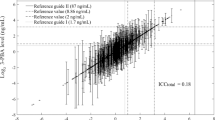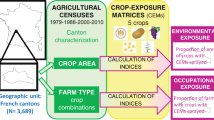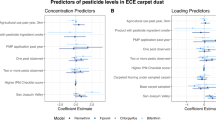Abstract
Pesticides are widely used in the home and garden to kill insects, weeds and other unwanted pests. There is mounting evidence that this usage may also have health consequences particularly on children. Using the ALSPAC cohort of 13,391 families with self-reported usage data up to age 4 years of the study child, the main users of pesticides appeared to be older, Caucasian, better educated, have higher incomes and more likely to own their home or to belong to non-manual social classes compared to less frequent users. There was some suggestion that different factors may affect weed-killer compared to other pesticide use. In particular, income appeared unrelated to other pesticide use. This may reflect different attitudes to indoor compared to garden applications. Alternatively, it may reflect whether the main user was the mother or the partner. Some authorities are currently encouraging domestic users to consider other non-chemical means of pest control before using pesticides. These results may help in targeting particular groups if further reductions in pesticide usage are desired. They have also helped in identifying the important confounders for adjusting future analyses on the potential health consequences of pesticides and weed-killers.
This is a preview of subscription content, access via your institution
Access options
Subscribe to this journal
Receive 6 print issues and online access
$259.00 per year
only $43.17 per issue
Buy this article
- Purchase on Springer Link
- Instant access to full article PDF
Prices may be subject to local taxes which are calculated during checkout
Similar content being viewed by others
References
Adgate J.L., Barr D.B., Clayton C.A., Eberly L.E., Freeman N.C., Lioy P.J., Needham L.L., Pellizzari E.D., Quackenboss J.J., Roy A., and Sexton K. Measurement of children's exposure to pesticides: analysis of urinary metabolite levels in a probability-based sample. Environ Health Perspect 2001: 109(6): 583–590.
Adgate J.L., Kukowski A., Stroebel C., Shubat P.J., Morrell S., Quackenboss J.J., Whitmore R.W., and Sexton K. Pesticide storage and use patterns in Minnesota households with children. J Expo Anal Environ Epidemiol 2000: 10(2): 159–167.
Armstrong B. Exposure measurement error: consequences and design issues. In: Nieuwenhuijsen M.J. (Ed.). Exposure Assessment in Occupational and Environmental Epidemiology. Oxford University Press, Oxford, 2003 pp. 181–200.
Bearer C.F. How are children different from adults? Environ Health Perspect 1995: 103(Suppl 6): 7–12.
Berkowitz G.S., Obel J., Deych E., Lapinski R., Godbold J., Liu Z., Landrigan P.J., and Wolff M.S. Exposure to indoor pesticides during pregnancy in a multiethnic, urban cohort. Environ Health Perspect 2003: 111(1): 79–84.
Buckley J.D., Meadows A.T., Kadin M.E., Le Beau M.M., Siegel S., and Robison L.L. Pesticide exposures in children with non-Hodgkin lymphoma. Cancer 2000: 89(11): 2315–2321.
Chance G.W., and Harmsen E. Children are different: environmental contaminants and children's health. Can J Public Health 1998: 89(Suppl 1): S9–S19.
Colt J.S., Lubin J., Camann D., Davis S., Cerhan J., Severson R.K., Cozen W., and Hartge P. Comparison of pesticide levels in carpet dust and self-reported pest treatment practices in four US sites. J Expo Anal Environ Epidemiol 2004: 14(1): 74–83.
Cordier S., Iglesias M.J., Le Goaster C., Guyot M.M., Mandereau L., and Hemon D. Incidence and risk factors for childhood brain tumors in the Ile de France. Int J Cancer 1994: 59(6): 776–782.
Daniels J.L., Olshan A.F., and Savitz D.A. Pesticides and childhood cancers. Environ Health Perspect 1997: 105(10): 1068–1077.
Daniels J.L., Olshan A.F., Teschke K., Hertz-Picciotto I., Savitz D.A., Blatt J., Bondy M.L., Neglia J.P., Pollock B.H., Cohn S.L., Look A.T., Seeger R.C., and Castleberry R.P. Residential pesticide exposure and neuroblastoma. Epidemiology 2001: 12(1): 20–27.
Davis J.R., Brownson R.C., and Garcia R. Family pesticide use in the home, garden, orchard, and yard. Arch Environ Contam Toxicol 1992: 22(3): 260–266.
Donaldson D., Kiely T., and Grube A. Pesticides Industry Sales and Usage: 1998 and 1999 Market Estimates. EPA, USA, 2002 EPA-733-R-02-001.
Drever F., and Whitehead M., (Eds.). Health Inequalities: Decennial Supplement, Series DS No. 15. The Stationery Office, London, 1997.
Faustman E.M., Silbernagel S.M., Fenske R.A., Burbacher T.M., and Ponce R.A. Mechanisms underlying Children's susceptibility to environmental toxicants. Environ Health Perspect 2000: 108(Suppl 1): 13–21.
Feagan R.B., and Ripmeester M. Contesting natural(ized) lawns: a geography of private green space in the niagara region. Urban Geogr 1999: 20(7): 617–634.
Fenske R.A., Black K.G., Elkner K.P., Lee C.L., Methner M.M., and Soto R. Potential exposure and health risks of infants following indoor residential pesticide applications. Am J Public Health 1990: 80(6): 689–693.
Golding J., Pembrey M., Jones R., and the ALSPAC Study Team. ALSPAC — the Avon Longitudinal Study of Parents and Children. I. Study methodology. Paediatr Perinat Epidemiol 2001: 15(1): 74–87.
Grey C.N.B. Household Pesticides in the UK: Use Risk Perception and Policy Implications, PhD Thesis, University of London, 2003.
Grey C.N.B., Nieuwenhuijsen M.J., Golding J., and the ALSPAC Study Team. The use and disposal of household pesticides. Environ Res 2005: 97(1): 109–115.
Grieshop J.I., and Stiles M.C. Risk and home-pesticide users. Environ Behav 1989: 21(6): 699–716.
Grieshop J.I., Stiles M.C., and Bone P.S. Selecting pesticides and nonchemical alternatives: green thumbs’ rules of thumb decision tools. J Consum Aff 1992: 26(1): 129–145.
Guillette E.A., Meza M.M., Aquilar M.G., Soto A.D., and Garcia I.E. An anthropological approach to the evaluation of preschool children exposed to pesticides in Mexico. Environ Health Perspect 1998: 106(6): 347–353.
Heeren G.A., Tyler J., and Mandeya A. Agricultural chemical exposures and birth defects in the Eastern Cape Province, South Africa A case–control study. Environ Health 2003: 2(1): 11.
Hurst P., Hay A., and Dudley N. The Pesticide Handbook. Journeyman Press, London; Concord, MA, 1991.
Infante-Rivard C., Labuda D., Krajinovic M., and Sinnett D. Risk of childhood leukemia associated with exposure to pesticides and with gene polymorphisms. Epidemiology 1999: 10(5): 481–487.
Leiss J.K., and Savitz D.A. Home pesticide use and childhood cancer: a case–control study. Am J Public Health 1995: 85(2): 249–252.
Lu C., Knutson D.E., Fisker-Andersen J., and Fenske R.A. Biological monitoring survey of organophosphorus pesticide exposure among pre-school children in the Seattle metropolitan area. Environ Health Perspect 2001: 109(3): 299–303.
Ma X., Buffler P.A., Gunier R.B., Dahl G., Smith M.T., Reinier K., and Reynolds P. Critical windows of exposure to household pesticides and risk of childhood leukemia. Environ Health Perspect 2002: 110(9): 955–960.
Meinert R., Schuz J., Kaletsch U., Kaatsch P., and Michaelis J. Leukemia and non-Hodgkin's lymphoma in childhood and exposure to pesticides: results of a register-based case-control study in Germany. Am J Epidemiol 2000: 151(7): 639–646; discussion 647–650.
Muldoon S.R., and Hodgson M.J. Risk factors for nonoccupational organophosphate pesticide poisoning. J Occup Med 1992: 34(1): 38–41.
OPCS (Office for Population Censuses and Surveys). Standard Occupational Classification, Volume 3. HMSO, London, 1991.
Plunkett L., Trunbull D., and Rodricks J. Differences between adults and children affecting exposure assessment. In: Guzelian P., Henry C., Olin S. (Eds.). Similarities and Differences Between Children and Adults: Implications for Risk Assessment. ILSI Press, Washington, DC, 1992 pp. 79–94.
Pogoda J.M., and Preston-Martin S. Household pesticides and risk of pediatric brain tumors. Environ Health Perspect 1997: 105(11): 1214–1220.
Porter W.P., Jaeger J.W., and Carlson I.H. Endocrine, immune, and behavioral effects of aldicarb (carbamate), atrazine (triazine) and nitrate (fertilizer) mixtures at groundwater concentrations. Toxicol Ind Health 1999: 15(1–2): 133–150.
Robbins P., Polderman A., and Birkenholtz T. Lawns and toxins: an ecology of the city. Cities 2001: 18(6): 369–380.
Robbins P., and Sharp J.T. Producing and consuming chemicals: the moral economy of the American Lawn. Econ Geogr 2003: 79(4): 425–451.
Savage E.P., Keefe T.J., Wheeler H.W., Mounce L., Helwic L., Applehans F., Goes E., Goes T., Mihlan G., Rench J., and Taylor D.K. Household pesticide usage in the United States. Arch Environ Health 1981: 36(6): 304–309.
Sexton K., Adgate J.L., Eberly L.E., Clayton C.A., Whitmore R.W., Pellizzari E.D., Lioy P.J., and Quackenboss J.J. Predicting children's short-term exposure to pesticides: results of a questionnaire screening approach. Environ Health Perspect 2003: 111(1): 123–128.
Thompson J.P., Casey P.B., and Vale J.A. Suspected paediatric pesticide poisoning in the UK. II — Home Accident Surveillance System 1989–1991. Hum Exp Toxicol 1994: 13(8): 534–536.
UK PSD (Pesticides Safety Directorate). Home and Garden use. Available at: http://www.pesticides.gov.uk/safe_use.asp?id=40Accessed September, 2004.
US EPA (Environmental Protection Agency). What is Integrated Pest Management (IPM)?. Available at: http://www.epa.gov/pesticides/about/faqs.htm#ipmAccessed October, 2004.
Weidner I.S., Moller H., Jensen T.K., and Skakkebaek N.E. Cryptorchidism and hypospadias in sons of gardeners and farmers. Environ Health Perspect 1998: 106(12): 793–796.
Whitmore R.W., Kelly J.E., and Reading P.L. National Home and Garden Pesticide Use Survey. Research Triangle Institute, 1992 RTI/5100/17-01F.
Whyatt R.M., Camann D.E., Kinney P.L., Reyes A., Ramirez J., Dietrich J., Diaz D., Holmes D., and Perera F.P. Residential pesticide use during pregnancy among a cohort of urban minority women. Environ Health Perspect 2002: 110(5): 507–514.
Acknowledgements
We would like to express their sincere thanks to Professor Jean Golding for her help throughout this study. We are also extremely grateful to all the mothers who took part and to the midwives for their cooperation and help in recruitment. The whole ALSPAC study team comprises interviewers, computer and laboratory technicians, clerical workers, research scientists, volunteers and managers who continue to make the study possible. This study could not have been undertaken without the financial support of the Medical Research Council, the Wellcome Trust, UK government departments, the National Institutes of Health, a variety of medical research charities and commercial companies. The ALSPAC study is part of the WHO initiated European Longitudinal Study of Pregnancy & Childhood.
Author information
Authors and Affiliations
Consortia
Corresponding author
Rights and permissions
About this article
Cite this article
Steer, C., Grey, C. & The ALSPAC Study Team. Socio-demographic characteristics of UK families using pesticides and weed-killers. J Expo Sci Environ Epidemiol 16, 251–263 (2006). https://doi.org/10.1038/sj.jea.7500455
Received:
Accepted:
Published:
Issue Date:
DOI: https://doi.org/10.1038/sj.jea.7500455
Keywords
This article is cited by
-
Impact of population characteristics on Illinois childcare adoption of integrated pest management (IPM)
Journal of Public Health (2012)
-
Residential landscapes as social-ecological systems: a synthesis of multi-scalar interactions between people and their home environment
Urban Ecosystems (2012)
-
Selection bias in case–control studies on household exposure to pesticides and childhood acute leukemia
Journal of Exposure Science & Environmental Epidemiology (2010)
-
The Influence of Diverse Values, Ecological Structure, and Geographic Context on Residents’ Multifaceted Landscaping Decisions
Human Ecology (2010)
-
The urban fire ant paradox: native fire ants persist in an urban refuge while invasive fire ants dominate natural habitats
Biological Invasions (2007)



